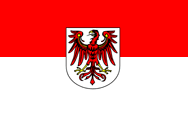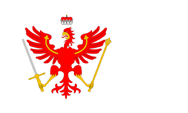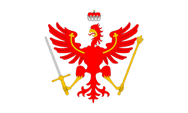
1618(?)–1701,
Flag of the Electorate,
Source, by: www.deutsche-schutzgebiete.de



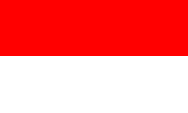
1882–1934,
Flag of the province



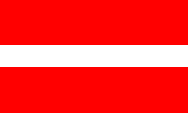
1949–1952, Flag of the country in the GDR,
Source, by: Flags of the World





The origin of the colors of the flag of Brandenburg is to find in the "Marconian Eagle", a coat of arms showing a red eagle on white (silver) background. In this form it was used as a heraldic flag of the Electorate of Brandenburg The flag of the Electorate showed the eagle, added by a princely cap, scepter and sword. For the Electoral Navy was created a variant, which had moved the eagle more toward the mast to allow a proper identification of the ship during week winds. If these flags were continued to use, after Brandenburg became in 1701 a part of the Kingdom of Prussia, is not known, but unlikely. Even the much easier to produce striped flag with the colors of the country, was officially introduced not until 1882 for the Prussian Province of Brandenburg.
From 1875, the provinces of Prussia could largely operate in self-governing. There was a provincial parliament and a provincial government (Provincial Committee). Each province had its own colors (Landesfarben), which were also used as flag, and they had also their own coat of arms. If the provincial governments put for official purposes (official flag) their coats of arms on a flag with the provincial colors is not handed down beyond doubt and not for all provinces.
Another incident for the flag was the seizure of power by the National Socialists in the German Empire in 1933. All official non-swastika flags, that refered to federalism, regional references or the old German Empire were abolished between 1933 and 1935. For the National Socialists, the federal structure of the German Empire, its historically grown countries, was considered as outdated, as relics of a past to be overcome. In this sense, several laws were enacted, on 31st of March in 1933 the 'Provisional Law for the phasing of the countries with the Empire', on 7th of April 1933 the 'Second Law for the phasing of the countries with the Empire' and finally, on 30th January in 1934 the 'Law on the rebuilding of the empire'. Thus, the federal structure of the German Empire was replaced by the gau-structure of the NSDAP, the countries became meaningless. From now on, offices and authorities had to use the swastika flag as official flag, until September 15th in 1935, when by the flag-law was legislated a new created official flag for all the offices and authorities of the empire. The prime ministers of the countries, which latest in 1933 all came from the NSDAP – now mostly called Reichsstatthalter (maybe translated as 'governor') – however remained in office until 1945. This was then also applied on the provinces of the state of Prussia. Their sovereign duties were taken over by the Gau structure of the NSDAP, which sometimes coincided with the borders of the provinces and sometimes they were new created. The respective provincial flags disappeared. The corresponding country colours continued, with restrictions, but definitly not in the form of flags. They were used, for example, occasionally on uniforms of the SA or in some ranks of the Hitler Youth in the breast cord.
After the war, the administration within the German Empire was rebuilt, but locally, following the structure of the countries. These have been partly old countries, and some new countries were created. Sometimes they bethought the old country colours and reactivated them – or they created new ones – for limited sovereign duties, which were under the control of the Allies. However, the eastern parts of Prussia were occupied by Soviet troops from 1944, and most of them came under Polish or Russian administration. The process described above did not come into being – also in Eastern Brandenburg (Neumark) – the German population was forcibly expelled and the old regional flags no longer played a role.
The western part of Brandenburg was as new foundet as a country in 1945 and became in 1949 a country of the GDR. In this way was introduced a new red-white-red flag. The width of the strips was in the ratio of 2:1:2. It became abolishesd on the occasion of the dissolution of the Country of Brandenburg in 1952. As the state of Brandenburg was re-established in 1991, they remembered the stripes-flag of the the Prussian province. In the middle of the flag was placed the old Brandenburg coat of arms with the "Marconian Eagle".
Source: 1) Wikipedia (D),
2) Wikipedia (D),
World Statesmen,
Volker Preuß,
Jürgen Kaltschmitt,
Uniform-Fibel

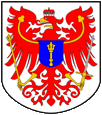
1864–1945,
Coat of arms of Brandenburg
Source, by: Flags of the World

1945–1952,
Coat of arms of Brandenburg
Source, by: Flags of the World
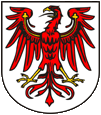
since 1991,
Coat of arms of Brandenburg
Source, by: Flags of the World

The coat of arms of Brandenburg shows the "Marconian Eagle". The eagle was used for the first time from the Ascanian Otto I. in 1170. The Ascanians probably introduced this symbol, because they as important representations of the nobility and imperial princes – as well as other important families – used the imperial eagle (black eagle on gold) in their coats of arms or even took it over completely. The family line of the Brandenburg Ascanians could have recolored this symbol for the today's Marconian Eagle. It was retained as the emblem of the Margraviate Brandenburg, regardless ruled by the Wittelsbach dynasty, Luxembourgers or the Hohenzollern dynasty. The Hohenzollern became in 1415 the Margraves of Brandenburg. The golden eagle is golden armoured and wears golden clover stems.
In 1824 was officially decided to equip the eagle with scepter and sword, and to crown with a princely cap, like it already was usual in the Electorate of Brandenburg, where the sword came into the left hand of the eagle, because a small error in the coat of arms of 1804 was continued. In 1864 the coat of arms was changed again, it was attached a blue shield on the chest of the eagle, which showed a golden scepter in his center. It symbolizes the dignity of the Erzkaemmerer of the Holy Roman Empire of German Nation.
In 1945 – immediately after the Second World War – all Prussian and Brandenburg symbolism was banished from the arms, to wipe out all memory of Prussia, which the Allies had already beaten in pieces, and finally disbanded in 1947. In Brandenburg they chosed a red-white-red shield (the colors of the flag), within a green oak tree in front of a sunrise in the background. At the edge was placed the year 1945 as a sign of the watershed. In the upper corner appeared the colours of Brandenburg Town in a small crest. A silvery band that graced the head and the edges of the shield showed the country's name as "Mark Brandenburg".
In 1991 the Country of Brandenburg became re-established, and they re-introduced an coat of arms with the golden armored Marconian Eagle with golden clover stems, but without the blue central shield, without sword and scepter. In 1993 the clover stems have seen some little changes.
Source: Wikipedia (D),
Flags of the World,
Volker Preuß

FRG and its countries, clickable map:
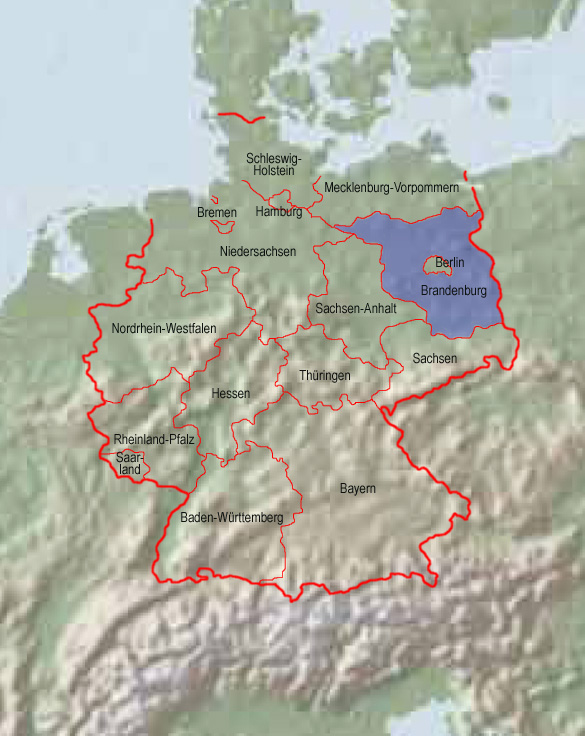
Source: Freeware, University of Texas Libraries, modyfied by: Volker Preuß

Area: 11.381 square miles
Inhabitants: 2.498.000 (2011)
Density of Population: 219 inh./sq.mi.
Religions: 75% Non-Religious, 17% Protestant, 3% Roman Catholic
Sprachen: German and some Sorb
Capital: Potsdam, 157.000 inh. (2010)
Currency to 1876: Prussian Currency
Currency 1876–1924: 1 Mark = 100 Pfennig
Currency 1924–1948: 1 Reichsmark (RM) = 100 Reichspfennig (Rpf.)
Currency 1948–1952: 1 Mark der Deutschen Notenbank (MDN) = 100 Pfennig (Pf.)
Source:
Wikipedia (D),
Der Michel

about Christ's birth · In today's Brandenburg settle the Germanic Semnones
about 160 A.D. · parts of the Germanic Lombards cross the land on the way to Pannonia
about 400 · in the south of Brandenburg settle the Germanic Thuringians, in the north settle the Semnones
5th century · one more cross Germanic Lombards the land on the way to Pannonia
6th century · immigration of the Slavic tribes of the Hevelli, Lusatians and Wilzen
929 · the German King Henry I. conqueres with an army the settlement area of the Hevelli, in this way Brandenburg Castle, establish of the Nordmark (North Mark), christianization
983 · Slavs revolt, recapturing of the Nordmark by the Slavs
11th century · wars of the Hevelli with Poland and Germany
1150 · Pribislaw, Prince of the Hevelli, dies childless, the Ascanian Albrecht the Bear inherits the Principality
1153 · The Slavs prince Jaxos conqueres Brandenburg Castle
1157 · Albrecht the bear re-captures Brandenburg Castle, establish of the Mark Brandenburg, Margraves become the Ascanian dynasty, immigration of Germans and Flemings
1320 · extinction of the Brandenburg Ascanians
1322 · Brandenburg comes to the Wittelsbach dynasty, deterioration of the Mark Brandenburg
1373 · Brandenburg comes to the Luxemburg dynasty, further deterioration of the Mark Brandenburg
1411 · Brandenburg comes to the Hohenzollern dynasty, reconstruction of the country
1415 · the Margraviate of Brandenburg becomes an Electorate
1618 · Elector Joachim Friedrich of Brandenburg inherites the Duchy of Prussia
1674–1675 · invasion of Swedish troops
1675 · victory over the Swedish troops at Fehrbellin
1683–1720 · Brandenburg-Prussian Fort Grossfriedrichsburg at the Gold Coast in Africa
1685–1709 · Brandenburg-Prussian Fort Dorothea at the Gold Coast in Africa
1694–1708 · Brandenburg-Prussian Fort Takrama at the Gold Coast in Africa
18th of January in 1701 · Elector Friedrich III. crowns himself to the "King in Prussia" in Koenigsberg, the Electorate of Brandenburg becomes a part of Prussia
1815 · Brandenburg becomes a Prussian province, the Electorate ends
1920 · Berlin is detached from the province of Brandenburg
1939–1945 · Second World War, defeat of the German Empire, Brandenburg is occupied by Soviet troops
1945–1947 · Prussian territories become torn piece by piece out of the country and become added to other partly newly created countries, the province of Brandenburg becomes detached from Prussia in 1945
1945–1949 · the areas of Brandenburg eastern of the Oder and Neisse Rivers become occupied by Polish, expulsion of 600.000 Germans from eastern Brandenburg, 207.000 of them become murdered or die during flight and expulsion
25th of February in 1947 · Prussia is resolved by Act No. 46 of the Allied Control Council
July 1947 · rename into "Land Brandenburg"
7th of October in 1949 · founding of the GDR, Brandenburg becomes a country of GDR
1952 · administrative reform in the GDR, the state of Brandenburg becomes abolished and divided into the three Districts of Cottbus, Frankfurt (Oder) and Potsdam, Perleberg comes to the district of Schwerin, Prenzlau and Templin to the District of Neubrandenburg
Summer 1989 · departure and exodus from the GDR
Autumn 1989 · mass demonstrations, initially for democracy and later for the reunification of Germany
9th of November in 1989 · Fall of the "Berlin Wall"
3rd of October in 1990 · unification of GDR and the FRG, re-establish of the Country of Brandenburg by unification of the districts of Cottbus (without the districts Hoyerswerda, Jessen, and Weisswasser), Frankfurt (Oder) and Potsdam, including districts of Perleberg, Prenzlau and Templin
1996 · a referendum decides against a union of the countries of Berlin and Brandenburg
Source: Atlas zur Geschichte,
Wikipedia (D),
Schwarzbuch der Vertreibung

The country's name of "Brandenburg" has its roots in the old "Brennaburg" ("Brenna Castle"). This was a stronghold of the Slavic Hevelli Tribe, which was conquered in 928 by King Henry 1st. The Ascanian Albrecht the Bear inherited the castle and the lands in 1157 and called itself now "Margrave of Brandenburg." The name of the old castle could go back to Saxon word for "burning", or to the Old Slavic word "branibor" which means "protectional forest".
Sometimes appears the old name "Mark Brandenburg", last seen in the arms of Brandenburg from 1945. What is a mark?
The word "mark" comes from the Latin word "marca", which means "border". So is clarified the position of a mark on the border of a special area. The marks (marches) of the German Empire were placed outside the actual territory of the empire, on conquered or otherwise owned land. Their tasks were to secure the empire by castles and garrisons, christianization, settlement of fortified farmers. The managing of a mark was assigned to a Margrave. There were several marks, at very different times. Known are the Mark of the Billungers in today's Mecklenburg, the North Mark (today's Brandenburg), the Mark Meissen (today's Saxony), the Mark of Verona in northern Italy, or the Eastern Marches in the east of today's Austria, to name only a few.
Source: Handbuch der geographischen Namen,
Discovery '97,
Atlas zur Geschichte







![]()




